Results: California Carrot Organic Variety Trials, 2014-2017 - Organic Seed Alliance
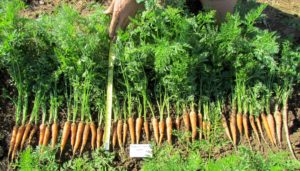
Publication date: August 27, 2018
Author: Steve Peters, Organic Seed Alliance
Funder: Gaia Fund
Table of Contents
- Introduction
- Materials and Methods
- Discussion and Results – Trial 1
- Discussion and Results – Trial 2
- Discussion and Results – Trial 3
- Discussion and Results – Trial 4
- Summary
Introduction
The focus of these trials was to evaluate the performance of fresh market bunching carrots, particularly Nantes types. A few other fresh bunching varieties of Kuroda, Chantenay and Danvers types were also included for a broader comparison. Four trials were conducted over a 2-½ year period, with three late summer sowings (2014, 2015, 2016) and one spring sowing (2016). Open pollinated (OP) varieties were emphasized, but a few leading F1 hybrids were included in each trial. Three OP varieties — Nantes Coreless, Rumba, and Scarlet Nantes — were grown in all four trials. Bolero, Kuroda Chantenay and New Kuroda were grown three times, while the remaining varieties were grown once or twice. Varieties were subtracted or added to subsequent trials based on their performance.
Materials and Methods
The trials were conducted on land farmed by professional seedsman Ronald Welten in an isolated field about 2 miles west of Gilroy, California. The soil is a fertile Pacheco silt loam situated alongside a year-round creek. See Table 1 for average high and low temperatures for Gilroy during the months that the carrots were grown.
All four trials conducted between August 2014 and January 2017 followed these protocols:
- Each variety was replicated twice in the field (referred to as rep 1 and rep 2).
- Each plot was 10 bed-feet, with 4 rows per bed (i.e., 40 row-feet per plot and 80 row-feet per variety) and 11 inches between rows.
- Seeds were planted with a Jang precision hand planter, one-quarter to one-half inch depth at about one-half inch spacing within the row.
For the three trials that were planted in August, the field was overhead watered following planting. After the carrots germinated, drip irrigation was installed and remained the primary water source until mid-November. During the final two months, natural rainfall provided most of the water needed by the plants. Plots were initially weeded with a tractor-mounted cultivator, with a final hand weeding performed in mid-October.
For the trial that was planted in April, drip irrigation was installed upon carrot emergence and remained the primary water source until the crop was harvested. Weeds were controlled with a Hula Hoe during the first few weeks, with a final hand weeding about 6 weeks after planting.
Trial 1 – August 22, 2014 Plant Date
A total of 22 carrot varieties were trialed including 18 open-pollinated (OP) and four F1 hybrids. Carrot class types included 11 Nantes varieties, four Chantenay, four Kuroda, and three Danvers. See Table 2A for a list of varieties, sources, and ownership status.
Trial 2 – August 18, 2015 Plant Date
A total of 10 carrot varieties were trialed including eight OPs and two F1 hybrids. Class type included seven Nantes, two Kuroda, and one Kuroda/Chantenay. See Table 2B.
Trial 3 – April 27, 2016 Plant Date
A total of 19 carrot varieties were trialed including 14 OPs and 5 F1 hybrids. Class type was exclusively Nantes. See Table 2C.
Trial 4 – August 25, 2016 Plant Date
Nine (9) carrot varieties were trialed including 7 OPs and 2 F1 hybrids. Class type included 7 Nantes, 1 Kuroda, and 1 Kuroda/Chantenay. See Table 2D.
Discussion and Results – Trial 1
After the final hand weeding the plant stand was evaluated and top growth was measured on October 17. Marked differences in plant stands among the varieties indicated varying germination rate. A “good” stand meant no yield reduction, an “OK” stand might have a slight yield reduction, a “spotty” stand very likely would have a yield reduction, and a “poor” stand definitely would result in a significant yield reduction.
Most of the varieties had at least an “OK” stand in both replications for ‘Bolero’, ‘Early Milan’, ‘Nantes Coreless’, ‘Napoli’, ‘Nash’s Nantes’, ‘Rumba’, ‘Scarlet Nantes’ (Abbondanza and Turtle Tree), ‘Kuroda’, ‘Kuroda Chantenay’, ‘Red Core Chantenay’ (Abbondanza), ‘New Kuroda’, ‘Shin Kuroda’ and ‘Cumbre’.
Spotty germination in at least one rep occurred for ‘Caracas’, ‘Minicor’, ‘Scarlet Nantes’ (Uprising), ‘Yaya’, ‘Rodelika’, ‘Rolanka’ and ‘Red Core Chantenay’. ‘Berlicum 2’ was mistakenly not planted in one of the reps. As a result, yields were significantly reduced for these varieties.
The height of carrot tops may contribute to better weed control for the taller-topped varieties, although that is far from conclusive in this trial. Top height did vary considerably among varieties.
Tall-topped varieties (12-18 inches) included ‘New Kuroda’, ‘Rumba’, all three Scarlet Nantes cultivars, ‘Red Core Chantenay’ (Abbondanza) and ‘Bolero’.
Medium-sized tops (8-14 inches) included ‘Berlicum 2’, ‘Caracas’, ‘Early Milan’, ‘Kuroda’, ‘Kuroda Chantenay’, ‘Nantes Coreless’, ‘Nash’s Nantes’, ‘Rodelika’, ‘Shin Kuroda’, ‘Napoli’, and ‘Yaya’.
Short tops (4-10 inches) included ‘Minicor’, ‘Red Core Chantenay’ (Osborne), ‘Rolanka’, and ‘Cumbre’.
The first root harvest was conducted on December 9 from rep 1 of each variety, followed by a second harvest on December 30 from rep 2. (See Table 3A). The number of marketable roots were recorded for a harvest of 10 feet of a row. A desirable stand would ideally have roots that are spaced 1-2” apart in a row, or 60-120 carrots per 10 feet of row. The only varieties that yielded 60 or more marketable carrots were ‘Napoli’ (96), ‘Early Milan’ (84), ‘Bolero’ (77), and ‘Nash’s Nantes’ (73). Therefore, yields of all the other varieties were likely reduced, at least in part, because of sub-par germination and emergence.
Table 3A also reports the weight of marketable roots from 10 feet of row, and the average weight per single root.
Top five varieties for marketable root weight for the Nantes-type varieties: 1 ‘Napoli’, 2 ‘Bolero’, 3 ‘Early Milan’, 4 ‘Rumba’, 5 ‘Nash’s Nantes’
Top five varieties for root size: 1 ‘Nantes Coreless’, 2 ‘Yaya’, 3 ‘Scarlet Nantes’ (Uprising), 4 ‘Rumba’, 5 ‘Scarlet Nantes’ (Turtle Tree)
Table 4A reports qualitative data regarding several phenological traits including top quality, root smoothness, pack out, tip fill, shoulder quality, and uniformity. Numerical ratings were assigned for each trait with a “9” being the best and “1” being the worst. In the alternate analysis, varieties were judged relative only to each other, so at least one variety received the lowest rating (1) and the highest (9). The top Nantes varieties by phenological trait can be summarized as follows:
Top quality: 1 ‘Nash’s Nantes’, ‘Rumba’; 2 ‘Scarlet Nantes’ (Abbondanza), ‘Scarlet Nantes’ (Turtle Tree), ‘Bolero’, ‘Nantes Coreless’
Root smoothness: 1 ‘Bolero’, ‘Rumba’, ‘Scarlet Nantes’ (Abbondanza), ‘Scarlet Nantes’ (Turtle Tree), ‘Scarlet Nantes’ (Uprising), ‘Nantes Coreless’
Pack out: 1 ‘Bolero’, ‘Yaya’; 2 ‘Nantes Coreless’, ‘Scarlet Nantes’ (Turtle Tree), ‘Scarlet Nantes’ (Uprising), ‘Napoli’
Tip fill: 1 ‘Yaya’; 2 ‘Minicor’, ‘Nantes Coreless’; 3 ‘Scarlet Nantes’ (Uprising), ‘Napoli’
Shoulder quality: 1 ‘Bolero’, ‘Early Milan’, ‘Nantes Coreless’, ‘Napoli’, ‘Rumba’, ‘Scarlet Nantes’ (Abbondanza), ‘Scarlet Nantes’ (Turtle Tree), ‘Scarlet Nantes’ (Uprising)
Uniformity: 1 ‘Yaya’; 2 ‘Early Milan’, ‘Napoli’, ‘Scarlet Nantes’ (Abbondanza)
‘Bolero’ and ‘Yaya’ had the highest total score for these six traits, although most of the other Nantes types were not far behind. The only two varieties with significantly poorer scores were ‘Minicor’ and ‘Nash’s Nantes’.
Photo 1 shows ‘Nantes Coreless’, which was the best rated OP, although root shape and maturity was inconsistent. The top row was ideal while the bottom row included later maturing, pointed roots.
‘Napoli’ also had some inconsistency but less pronounced than ‘Nantes Coreless’.
A carrot tasting was conducted on January 18, 2015 from roots that had been harvested on December 30. (Table 5A). Three small pieces of carrot from three separate roots were sampled from each variety. The tasters were the author and his wife (Steve and Moria Peters). They wrote a few comments and then graded each variety. The most flavorful varieties were ‘Nantes Coreless’, ‘Nash’s Nantes’ and ‘Napoli’. However, taste varied significantly from root to root, and this was only one evaluation.
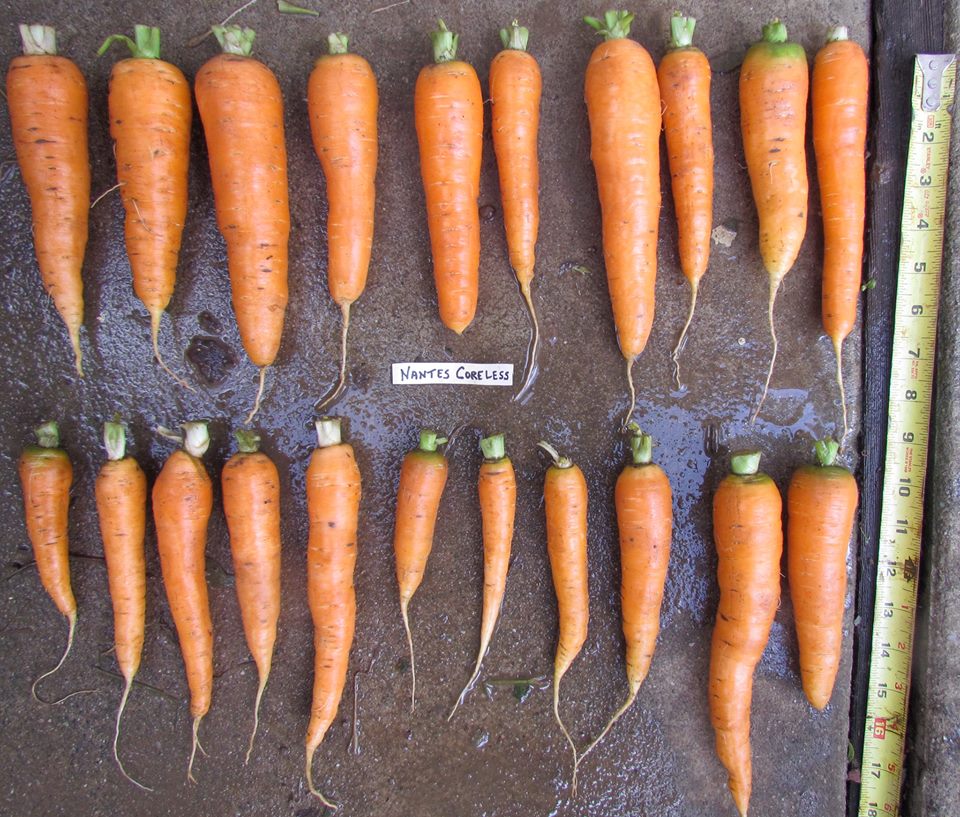
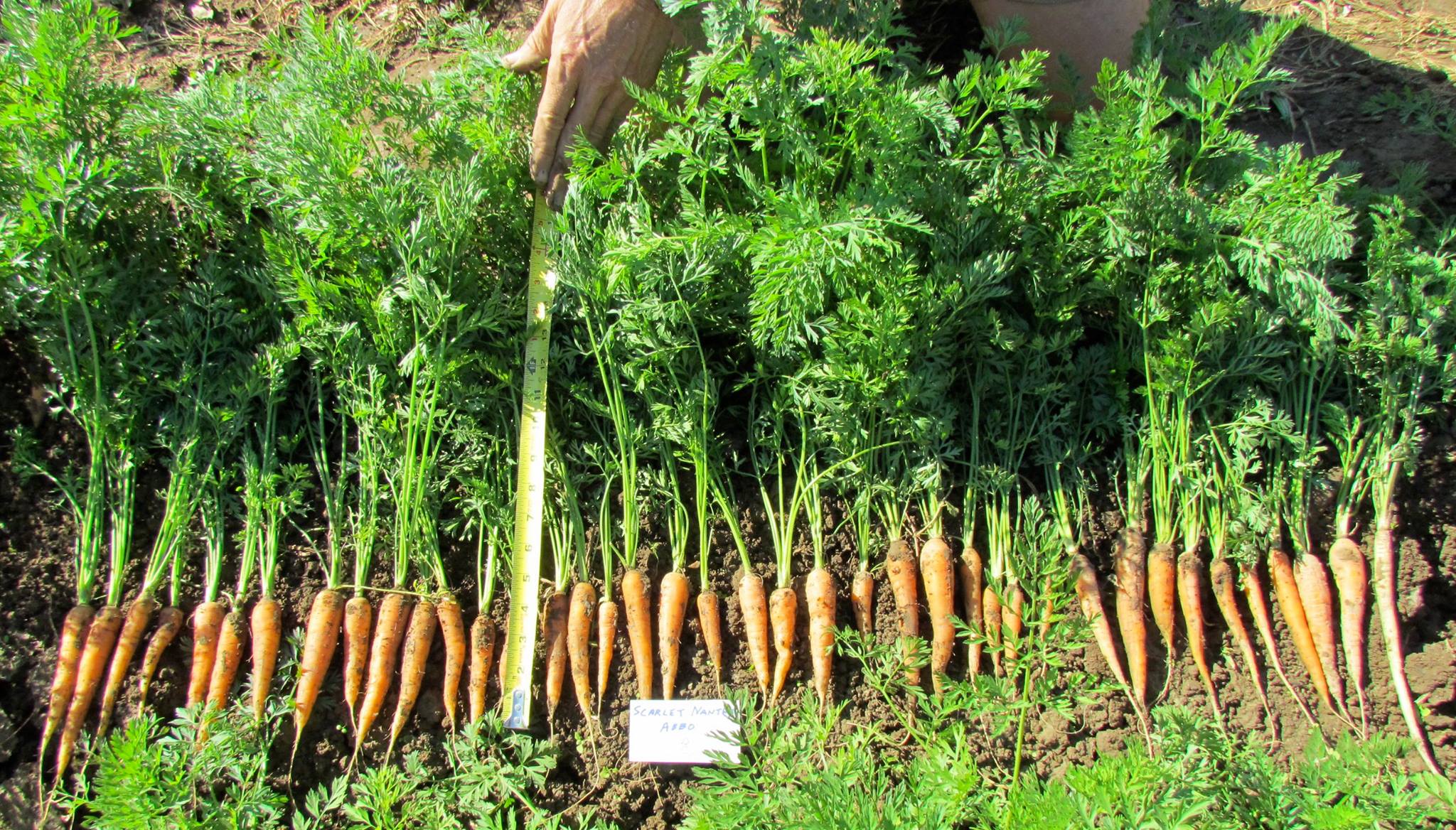
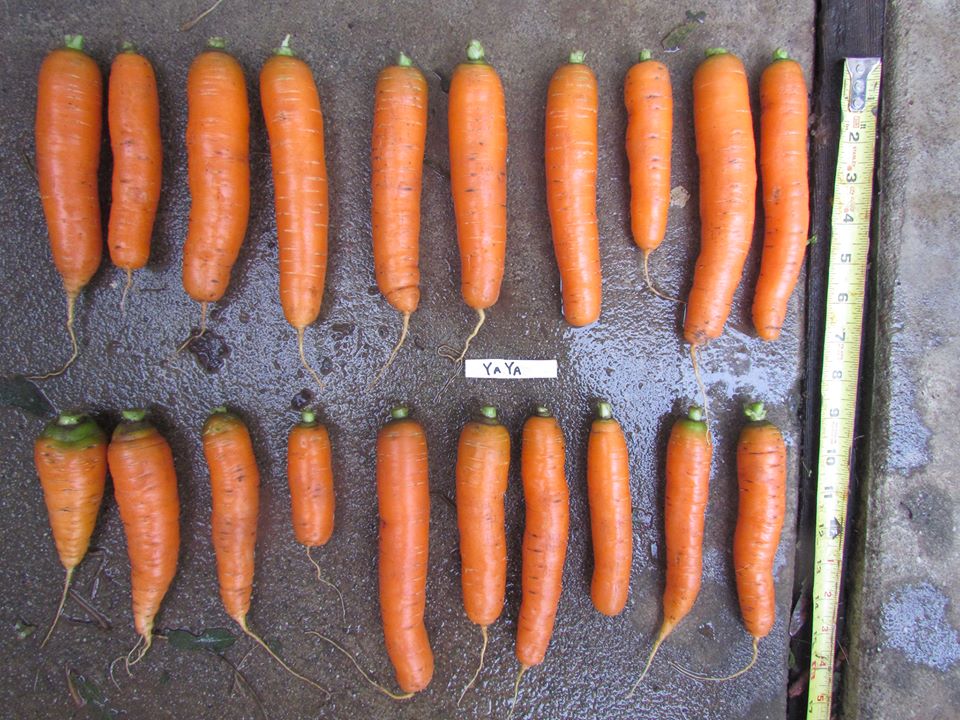
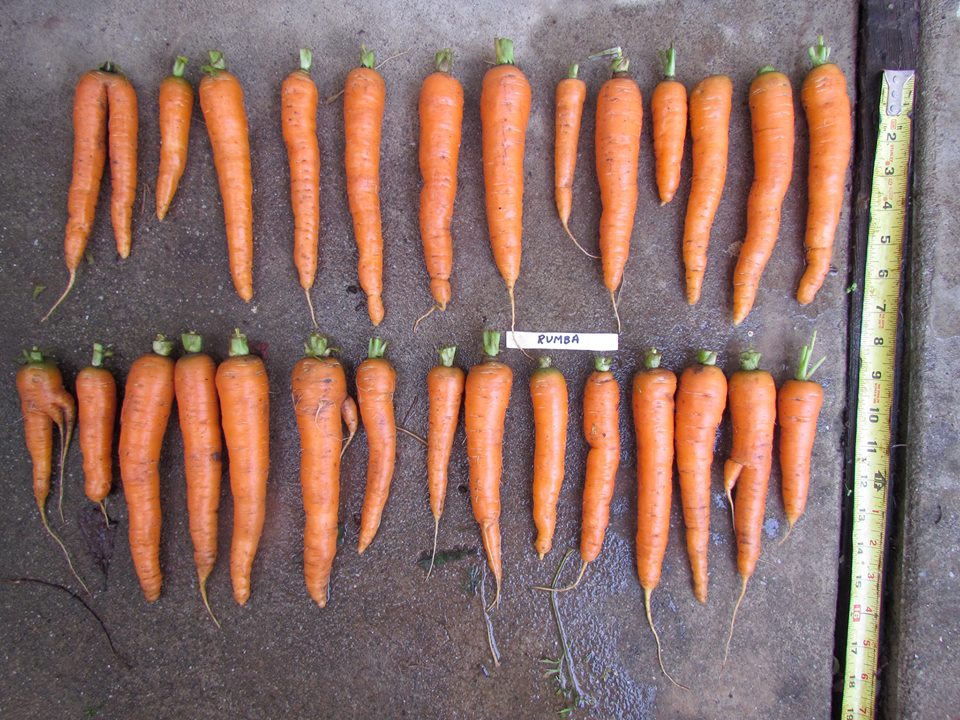
Overall Ranking Trial 1
Nantes Types
- ‘Nantes Coreless’ – This variety scored high for almost all characteristics. Of particular note were its excellent flavor, strong tops, smooth roots, large size, and nearly full blunting. The only negatives were low stand count (germ issue) and a lack of size uniformity.
- ‘Napoli’ – Its yield and uniformity were greater than Nantes Coreless, and eating quality was equally outstanding. However, it had smaller tops and less tip fill.
- ‘Bolero’ – An overall good performer with high yield, strong tops and smooth roots being its top attributes. The only real issue, perhaps, is the lack of tip fill and relatively small root size, but this was compensated for with good stand count and pack out. Pretty good flavor but sometimes bitter.
- ‘Yaya’ – The most fully blunted and uniform roots in the trial. Although its stand count was low, it had excellent pack out and high yield potential. Flavor was OK. Its biggest weaknesses were small, weak tops and the shoulders were slightly pinched.
- ‘Rumba’ – A vigorous variety with big tops, and smooth, medium-sized roots and a decent yield. Eating quality was average. The biggest issue was an almost complete lack of tip fill, which explains its low pack out rating.
- ‘Scarlet Nantes’ – All three strains of this variety – Abbondanza, Turtle Tree, and Uprising performed relatively equally, although there were some differences. Eating quality was equally OK for all three, and each had very smooth roots. However, the Abbondanza strain was smaller with less tip fill than the others, although the roots of the Abbondanza strain had a more uniform size and shape. The Uprising strain had the biggest roots and the smallest tops. The Turtle Tree strain had the least uniform roots.
- ‘Early Milan’ – Overall performance of this variety was not far behind ‘Rumba’ and the ‘Scarlet Nantes’ cultivars. It actually produced a higher marketable yield than all those other varieties due to its high stand count, and it was more uniform except for ‘Scarlet Nantes’ (Abbondanza). In comparison to the others, ‘Early Milan’ roots were smaller and tops were weaker. The flavor wasn’t notable.
- ‘Nash’s Nantes’ – Rated poorly in most traits including having small roots with rough skins, pinched shoulders and very little tip fill. Its best characteristic was strong, healthy top growth.
- ‘Minicor’ – This variety had a high degree of blunting, but all other traits rated average or below average.
Overall Ranking Trial 1
Kuroda, Chantenay, and Danvers Types
These types were not emphasized in this trial, but the Kurodas and Danvers types are reasonably comparable because they also can be categorized as fresh bunching carrots. The Chantenays should be considered more for processing and cooking.
The Kurodas are all larger than the Nantes, and yields would have exceeded the Nantes if the germination had been better. At the time of harvest most of the Kurodas had begun to split and were ready to harvest three weeks earlier. The overall rankings of the Kurodas for the six phenological traits evaluated were greater than the Nantes, except for ‘Shin Kuroda’. The primary negative for the Kurodas was the eating quality, which was consistently rather bland and watery, with a soft texture.
In the Chantenay class, ‘Cumbre’ was the real winner — it displayed no weaknesses and had a pleasing flavor and texture. The ‘Red Core Chantenay’ (Abbondanza) also ranked quite high, and its phenological total score exceeded all the Nantes varieties.
The Danvers types all performed rather poorly compared to the other kinds. The exceptions were that ‘Berlicum’ had good tops and shoulders, ‘Rodelika’ had good pack-out and shoulder quality, and ‘Rolanka’ had very strong tops.
Discussion and Results – Trial 2
The first root harvest of 10 feet of row was on November 20 from rep 1 for each variety. A second harvest, also of 10 feet of row, on November 25 was from rep 2. See Table 3B for harvest data. The number of marketable roots were recorded for harvesting 20 feet of row. A desirable stand would ideally have roots that are spaced 1-2 inches apart in a row, or 60-120 carrots per ten-feet of row. In contrast to the previous trial, all varieties had reasonably good germination and emergence. Therefore, all had greater than 60 marketable roots.
Table 3B also reports the weight of marketable roots from 20 feet of row, and the average weight per single root.
Top five varieties for marketable root weight for the Nantes-type varieties: 1 ‘Nantes’ , 2 ‘Rumba’, 3 ‘Bolero’, 4 ‘Nantes Coreless’, 5 ‘Scarlet Nantes’ (Abbondanza 2012 lot)
Top five varieties for root size: 1 ‘Nantes 2’, 2 ‘Nantes Coreless’, 3 ‘Bolero’, 4 ‘Yaya’, 5 ‘Scarlet Nantes’ (Abbondanza 2011 lot)
Table 4B reports qualitative data regarding several phenological key traits including top height, top density, pack out, and tip fill. The top Nantes varieties by phenological trait can be summarized as follows:
Top height: 1 ‘Nantes 2’; 2 ‘Nantes Coreless’; 3 ‘Rumba’, ‘Scarlet Nantes’ (Abbondanza 2011 lot), and ‘Scarlet Nantes’ (Abbondanza 2012 lot)
Top density: 1 ‘Nantes Coreless’ and ‘Nantes 2’, 2 ‘Rumba’ and ‘Scarlet Nantes’ (Abbondanza 2012 lot)
Pack out: 1 ‘Nantes Coreless’ and ‘Nantes 2’; 2 ‘Rumba’, ‘Scarlet Nantes’ (Abbondanza 2011 lot), and ‘Scarlet Nantes’ (Abbondanza 2012 lot)
Tip fill: 1 ‘Yaya’, 2 ‘Nantes 2’, 3 ‘Nantes Coreless’ and ‘Scarlet Nantes’ (Abbondanza 2012 lot)
A carrot tasting was conducted on December 10, 2015 from roots that had been harvested on November 20 and 25 (Table 5B). Three small pieces of carrot from three separate roots were sampled from each variety. The tasters were the author and his wife (Steve and Moria Peters) and a neighbor Elif Elgin. They wrote a few comments and then graded each variety. The most flavorful varieties were Bolero and Nantes Coreless. However, taste varied significantly from root to root, and this was only one evaluation.
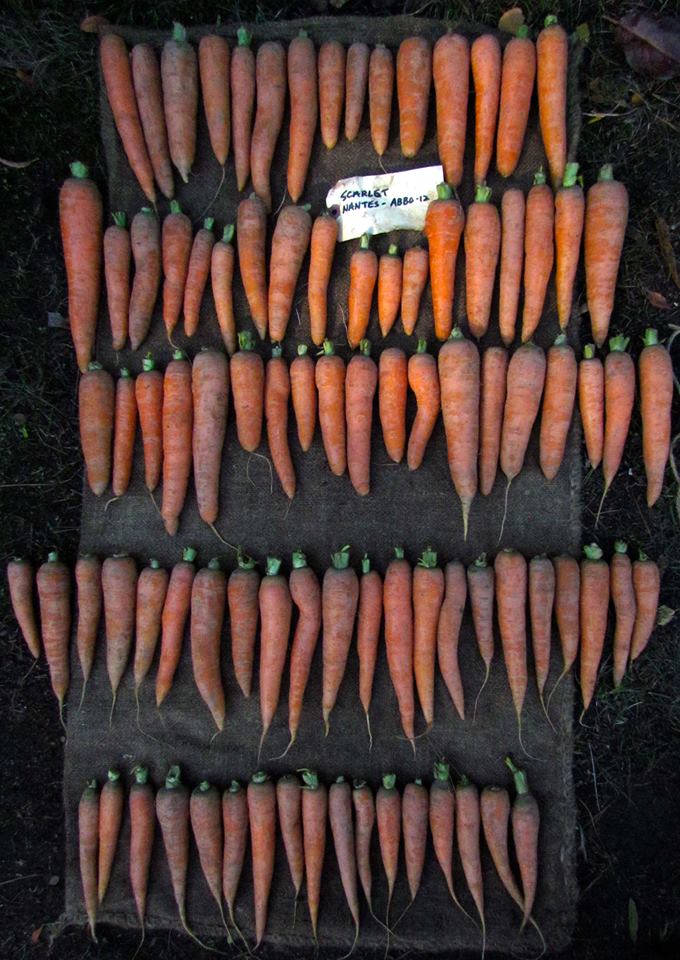
Overall Ranking Trial 2
Nantes Types
- ‘Nantes Coreless’ – Strong performer regarding top quality, pack out and tip fill, which indicates early maturing. It also ranked at the top for eating quality.
- ‘Nantes 2’ – Exceeded Nantes Coreless for top height and tip fill (earliness). The only hesitation for ranking it higher is that the flavor was rather mediocre.
- ‘Scarlet Nantes’ (Abbondanza 2012 lot) – The two seed lots from Abbondanza Seeds performed differently, likely the result of the heavier selection pressure imposed on the Abbondanza 2012 lot. The tops and pack out were similar for the two lots, but the Abbondanza 2012 lot matured more quickly, with good tip fill at the time of harvest. Flavor and texture was rated quite good.
- ‘Rumba’ – Tops and pack out were fairly decent, however this is a late-maturing variety with very little tip fill at the time of harvest. Flavor was described as somewhat bitter or not sweet.
- ‘Scarlet Nantes’ (Abbondanza 2011 lot) – Similar to the Abbondanza 2012 lot with OK tops and pack out. However, this lot is later maturing with little tip. Decent flavor.
- ‘Yaya’ – This variety was clearly superior regarding early maturity with almost complete tip fill. However, it had a high percentage of forked roots, weak tops and a low pack out. Flavor was rated pretty good.
- ‘Bolero’ – Usually this variety ranks higher. However, it was very late-maturing and almost no tip fill. It did have a decent yield and flavor ranked very high.
- ‘Amsterdam’ – It matures early with good tip fill, but tops are weak, roots are small and yield is low. Flavor rating was poor.
Discussion and Results – Trial 3
This was the only trial that was spring-planted (April 27). The first root harvest of 10 feet of row was on August 12 from rep 1 for each variety. A second harvest, also of 10 feet of row, on August 19 was from rep 2. (See Table 3C). A total of 20 carrot varieties were evaluated including 15 OPs and five F1 hybrids. Class type was exclusively Nantes. Stand density ranged considerably, although the great majority of varieties had an ideal spacing of 1.5 to 2 inches between roots
Top five varieties for marketable root weight for the Nantes-type varieties: 1 ‘Nantes Prima’, 2 ‘Bolero’, 3 ‘Nantes Coreless’, 4 ‘Scarlet Nantes’ (Farm Direct), 5 ‘Rumba’
Top five varieties for root size: 1 ‘Scarlet Nantes’ (Abbondanza 2012 lot), 2 ‘Miami’ 3 ‘Nantes Coreless’, 4 ‘Rothild’, 5 ‘Scarlet Nantes’ (Turtle Tree and Uprising)
Table 4C reports qualitative data regarding several phenological key traits including root smoothness, root shape, shoulder, and tip fill. Several varieties had very sparse plant stands and hence were not assigned numerical scores for the phenological traits. These varieties included ‘Scarlet Nantes’ (Abbondanza 2011 lot), ‘Minicor’, ‘Touchon’, ‘Early Milan’, and ‘Nantes 2’. The top Nantes varieties by phenological trait can be summarized as follows:
Root smoothness: 1 ‘Negovia’; 2 ‘Scarlet Nantes’ (Uprising) and ‘Romance’; 3 ‘Scarlet Nantes’ (Turtle Tree), ‘Scarlet Nantes’ (Abbondanza 2012 lot) and ‘Romance’
Root shape: 1 ‘Negovia’; 2 ‘Nantes Coreless’; 3 ‘Rumba’, ‘Scarlet Nantes’ (Abbondanza 2012 lot), ‘Scarlet Nantes’ (Turtle Tree), and ‘Scarlet Nantes’ (Farm Direct)
Shoulder: 1 ‘Scarlet Nantes’ (Abbondanza 2012 lot), ‘Scarlet Nantes’ (Farm Direct), and ‘Nantes 2’; 2 ‘Negovia’; 3 ‘Scarlet Nantes’ (Turtle Tree) and ‘Rumba’
Tip fill: 1 ‘Negovia’; 2 ‘Nantes Coreless’, ‘Scarlet Nantes’ (Abbondanza 2012 lot), and ‘Scarlet Nantes’ (Turtle Tree); 3 ‘Scarlet Nantes’ (Farm Direct) and ‘Nelson’
Total score: 1 ‘Negovia’; 2 ‘Scarlet Nantes’ (Abbondanza 2012 lot); 3 ‘Scarlet Nantes’ (Farm Direct) and ‘Scarlet Nantes’ (Turtle Tree), 4) ‘Nantes Coreless’ and ‘Rumba’
Overall Ranking Trial 3
Nantes Types
- ‘Negovia’ – Clearly superior regarding root smoothness, root shape uniformity and tip fill. Also, good shoulders. Average root size and marketable yield.
- ‘Scarlet Nantes’ – (Abbondanza 2012 lot, Farm Direct, and Turtle Tree) – All Scarlet Nantes varieties rated high for shoulders, root smoothness, uniform shape and early maturing (tip fill). All had average or above average marketable yields
- ‘Nantes Coreless’ – Excellent yield, tip fill and shape. Shoulders and root smoothness were average.
- ‘Rumba’ – Good shoulders, root smoothness, and shape, but a little later maturing. Root size is small but yield was pretty good.
- ‘Nantes Prima’ – Good root size and marketable yield. Below average for shoulders, root smoothness, Root shape, and tip fill.
- ‘Bolero’ – Excellent yield (due to high stand count). Ranked near the bottom for shoulders, root smoothness, root shape and tip fill.
- ‘Amsterdam’ – Average yield (due to high stand count), pretty consistent shape and decent shoulders. Poor tip fill and root smoothness.
- ‘Nelson’ – Average yield and good tip fill. Poor shoulders, root smoothness and inconsistent shape.
- ‘Nantes 2’ – Good shoulders. Marketable yield, root smoothness, root shape, and tip fill were all poor.
- ‘Rothild’ – Average shoulders. All other traits poor.
- ‘Miami’ – All traits were below average or poor.
The remaining varieties were not included in this ranking because of insufficient data.
Discussion and Results – Trial 4
A harvest of 10 roots from each rep (20 total roots) was conducted on January 13, 2017. (See Table 3D). These were evaluated for root size, percent of marketable roots, and percent of split or forked roots.
Root size (largest): 1 ‘Kuroda Chantenay’, 2 ‘Nantes Coreless’ (Seed rEvolution Now), 3 ‘New Kuroda’ and ‘Romance’, 4 ‘Nantes Coreless’ (Jardin del Alma)
Percentage of marketable roots (most): 1 ‘Romance’, 2 ‘Nantes Coreless’ (Jardin del Alma) and ‘Scarlet Nantes’ (Farm Direct), 3 ‘Kuroda Chantenay’ and ‘Nantes Coreless’ (Seed rEvolution Now)
Percentage of split and forked roots (least): 1 ‘Dolciva’, ‘Romance’ and ‘New Kuroda’, 2 ‘Scarlet Nantes’ (Abbondanza) and ‘Nectar’
Overall Ranking Trial 4
Nantes and Kuroda Types
- ‘Romance’ – good size, consistent shape, highest percent of marketable roots and no misshapen roots
- These five varieties are similarly ranked:
- ‘Kuroda Chantenay’ – largest size, high percent of marketable roots
- ‘New Kuroda’ – large size, no misshapen roots
- ‘Nantes Coreless’ (Seed rEvolution Now) – large size, high percent of marketable roots
- ‘Nantes Coreless’ (Jardin del Alma) – high percent of marketable roots
- ‘Dolciva’ – no misshapen roots
- These two varieties are similarly ranked:
- ‘Scarlet Nantes’ (Farm Direct) – had the most consistently well-shaped roots of all the OP’s, equal to Romance, although of a smaller size
- ‘Nectar’ – average for all qualities
- ‘Scarlet Nantes’ (Abbondanza) – small size, lower percent of marketable roots
- ‘Rumba’ – ranked last for size, percent of marketable roots and percentage misshapen roots
Summary
The goal of these trials was to evaluate bunching type carrots and identify open pollinated (OP) varieties that compared favorably with some of the leading commercial F1 hybrids. The Nantes carrots were emphasized, as they are the leading type in this market class. Most importantly, the OP varieties trialed are all in the public domain, and hence available for further improvements by farmers and plant breeders.
As a generalization across the four trials, the primary advantage of the F1 hybrids was having a more consistent shape and a higher percentage of number one, marketable roots, which resulted in a greater pack-out. Despite this, several of the OP varieties had very comparable or even higher yields, stronger tops and better shoulder quality. Continual good selection would insure that these OP’s are worthy commercial varieties. ‘Dolciva’, an OP bred by bio-dynamic growers at Sativa Seeds in Switzerland, has hybrid-like uniformity and productivity. This is perhaps the most commercially viable OP, although it was grown only once in these trials. ‘Nantes Coreless’ is one of the largest and earliest-maturing Nantes types, with good shape and smooth roots. It was originally selected in sub-tropical conditions and thrives in heat better than most others. ‘Nantes 2’ (Hilmar) had great size and earliness when harvested in late fall, and perhaps out-performed Nantes Coreless. However, it was less successful when grown during the summer. All the ‘Scarlet Nantes’ strains performed quite well for all the traits although more selection is needed for earlier maturity. In Photo 5 the two upper rows of ‘Scarlet Nantes’ (Abbondanza) have distinctly blunted tips, whereas the bottom two rows still have pointed tips and hence are less mature. If only the roots from the upper two rows were re-planted for seed, this could potentially shift the population toward maturing a few days earlier. ‘Rumba’ was less consistent than many other Nantes OPs, but it had the most vigorous top growth and could be valuable for breeding with weaker-topped varieties.
The other types of carrots were added for perspective. The Kurodas had good size and consistent shape but the eating quality was consistently poorer than the Nantes varieties. The Danvers types were vigorous and had strong shoulders, but had rough skins and often an unpleasant flavor. In contrast, the Chantenays had an exceptional flavor profile that was distinctly different than any of the other kinds. Chantenays, however, are not ideal for bunching as they have very broad shoulders and short root length.
The variety trials described in this report are essentially replicated screening trials. The sizes of the plots were quite small, which somewhat confounded the results when germination and stand count were sub-par (as was the case with some of the varieties). Also, the work was conducted on only one specific farm. A more complete evaluation would obviously require multiple trial sites and larger populations. Nevertheless, these studies do indicate relative strengths and weaknesses of a range of varieties, which can provide a guide for future plantings.
Table 1. Monthly average high and low temperatures, and rainfall
Source: US Climate Data. Weather Station coordinates (about 3 miles east of field site): Longitude – 121.561, Latitude – 37.003.
| Trial 1 – August 2014 to January 2015 |
||||||
| August | September | October | November | December | January | |
| Avg. high temp. (ºF) | 88 | 87 | 84 | 71 | 63 | 66 |
| Avg. low temp (ºF) | 57 | 57 | 51 | 45 | 45 | 39 |
| Precipitation (inches) | 0 | 0.21 | 0.43 | 2.06 | 8.67 | 0 |
| Trial 2 – August 2015 to January 2016 |
||||||
| August | September | October | November | December | January | |
| Avg. high temp. (ºF) | 79 | 85 | 81 | 63 | 57 | 59 |
| Avg. low temp (ºF) | 51 | 52 | 53 | 37 | 37 | 44 |
| Precipitation (inches) | 0.06 | 0.16 | 0.24 | 2.25 | 1.73 | 3.58 |
| Trials 3 & 4 – April 2016 to January 2017 |
|||||
| April | May | June | July | August | |
| Avg. high temp. (ºF) | 71 | 73 | 84 | 82 | 79 |
| Avg. low temp (ºF) | 47 | 51 | 52 | 52 | 53 |
| Precipitation (inches) | 1.01 | 0.36 | 0 | 0 | 0 |
| September | October | November | December | January | |
| Avg. high temp. (ºF) | 83 | 74 | 68 | 59 | 57 |
| Avg. low temp (ºF) | 50 | 49 | 44 | 38 | 39 |
| Precipitation (inches) | 0.38 | 2.49 | 0 | 1.66 | 0.47 |
Table 2. Carrot varieties
| Table 2A. Trial 1 | ||||
| Open pollinated | Production method | Class/type | Source | Ownership status |
| Berlicum 2 | Conventional | Danvers | Gourmet Seed International (CA) | Public Domain |
| Caracas | Conventional | Chantenay | Johnny’s Selected Seeds (ME) | Public Domain |
| Early Milan | Organic | Nantes | Turtle Tree Seeds (NY) | Public Domain |
| Kuroda | Conventional | Kuroda | Gourmet Seed International (CA) | Public Domain |
| Kuroda Chantenay | Organic | Kuroda | Abbondanza Seeds (CO) | Public Domain |
| Minicor | Organic | Nantes | Turtle Tree Seeds (NY) | Public Domain |
| Nantes Coreless | Organic | Nantes | Jardin del Alma (NM) | Public Domain |
| Nash’s Nantes | Organic | Nantes | Nash’s Organic Produce (WA) | Public Domain |
| New Kuroda | Conventional | Kuroda | Kitazawa Seeds (CA) | Public Domain |
| Red Core Chantenay | Organic | Chantenay | Abbondanza Seeds (CO) | Public Domain |
| Red Core Chantenay | Conventional | Chantenay | Osborne Seeds (WA) | Public Domain |
| Rodelika | Organic | Danvers | Turtle Tree Seeds (NY) | Public Domain |
| Rolanka | Organic | Danvers | Turtle Tree Seeds (NY) | Public Domain |
| Rumba | Organic | Nantes | Nash’s Organic Produce (WA) | Public Domain |
| Scarlet Nantes | Organic | Nantes | Abbondanza Seeds (CO) | Public Domain |
| Scarlet Nantes | Organic | Nantes | Turtle Tree Seeds (NY) | Public Domain |
| Scarlet Nantes | Organic | Nantes | Uprising Seeds (WA) | Public Domain |
| Shin Kuroda | Conventional | Kuroda | Fedco Seeds (ME) | Public Domain |
| F1 Hybrid | ||||
| Bolero | Conventional | Nantes | Johnny’s Selected Seeds (ME) | Limagrain/Proprietary |
| Cumbre | Conventional | Chantenay | Osborne Seeds (WA) | Nunhems (Bayer)/Proprietary |
| Napoli | Organic | Nantes | High Mowing Organic Seeds (VT) | Bejo Seeds/Proprietary |
| Yaya | Organic | Nantes | High Mowing Organic Seeds (VT) | Bejo Seeds/Proprietary |
| Table 2B. Trial 2 | ||||
| Open pollinated | Production method | Class/type | Source | Ownership status |
| Amsterdam | Conventional | Nantes | Gourmet Seed International (CA) | Public Domain |
| Kuroda Chantenay | Organic | Kuroda/Chantenay | Abbondanza Organic Seeds (CO) | Public Domain |
| Nantes Corelss | Organic | Nantes | Jardin del Alma (NM) | Public Domain |
| Nantes 2 (aka Hilmar) | Conventional | Nantes | Gourmet Seed International (CA) | Public Domain |
| New Kuroda | Conventional | Kuroda | Kitazawa Seeds (CA) | Public Domain |
| Rumba | Organic | Nantes | Nash’s Organic Produce (WA) | Public Domain |
| Scarlet Nantes | Organic | Nantes | Abbondanza Organic Seeds (CO) | Public Domain |
| Shin Kuroda | Conventional | Kuroda | Fedco Seds (ME) | Public Domain |
| F1 Hybrid | ||||
| Bolero | Conventional | Nantes | Johnny’s Selected Seeds (ME) | Limagrain/Proprietary |
| Yaya | Organic | Nantes | High Mowing Organic Seeds (VT) | Bejo Seeds/Proprietary |
| Table 2C. Trial 3 | ||||
| Open pollinated | Production method | Class/type | Source | Ownership status |
| Amsterdam | Conventional | Nantes | Gourmet Seed International (CA) | Public Domain |
| Early Milan | Organic/Biodynamic | Nantes | Turtle Tree Seeds (NY) | Public Domain |
| Minicor | Organic/Biodynamic | Nantes | Turtle Tree Seeds (NY) | Public Domain |
| Nantes 2 (aka Hilmar) | Conventional | Nantes | Gourmet Seed International (CA) | Public Domain |
| Nantes Coreless | Organic | Nantes | Jardin del Alma (NM) | Public Domain |
| Nantes Prima | Conventional | Nantes | Gourmet Seed International (CA) | Public Domain |
| Rothild | Conventional | Nantes | Gourmet Seed International (CA) | Public Domain |
| Rumba | Organic | Nantes | Nash’s Organic Produce (WA) | Public Domain |
| Scarlet Nantes | Organic | Nantes | Abbondanza Seeds (CO) | Public Domain |
| Scarlet Nantes | Organic/Biodynamic | Nantes | Turtle Tree Seeds (NY) | Public Domain |
| Scarlet Nantes | Organic | Nantes | Uprising Seeds (WA) | Public Domain |
| Scarlet Nantes | Organic | Nantes | Farm Direct Seeds (CO) | Public Domain |
| Touchon | Conventional | Nantes | Gourmet Seed International (NY) | Public Domain |
| F1 Hybrid | ||||
| Bolero | Conventional | Nantes | Johnny’s Selected Seeds (ME) | Limagrain/Proprietary |
| Miami | Organic | Nantes | High Mowing Organic Seeds (VT) | Bejo Seeds/Proprietary |
| Negovia | Organic | Nantes | High Mowing Organic Seeds (VT) | Bejo Seeds/Proprietary |
| Nelson | Conventional | Nantes | Johnny’s Selected Seeds (ME) | Bejo Seeds/Proprietary |
| Romance | Conventional | Nantes | Johnny’s Selected Seeds (ME) | Nanhems (Bayer)/Proprietary |
| Table 2D. Trial 4 | ||||
| Open pollinated | Production method | Class/type | Source | Ownership status |
| Dolciva | Conventional | Nantes | High Mowing Organic Seeds (VT)/Sativa (Germany) | Public Domain |
| Kuroda Chantenay | Organic | Kuroda | Feral Heart Farm (CA) | Public Domain |
| Nantes Coreless | Organic | Nantes | Seed rEvolution Now (CA) | Public Domain |
| Nantes Coreless | Organic | Nantes | Jardin del Alma (NM) | Public Domain |
| New Kuroda | Conventional | Kuroda | Kitizawa Seeds (CA) | Public Domain |
| Rumba | Organic | Nantes | Nash’s Organic Produce (WA) | Public Domain |
| Scarlet Nantes | Organic | Nantes | Abbondanza Organic Seeds (CO) | Public Domain |
| Scarlet Nantes | Organic | Nantes | Farm Direct Seeds (CO) | Public Domain |
| F1 Hybrid | ||||
| Nectar | Organic | Nantes | Johnny’s Selected Seeds (ME) | Bejo Seeds/Proprietary |
| Romance | Conventional | Nantes | Johnny’s Selected Seeds (ME) | Nunhems (Bayer)/Proprietary |
Table 3. Carrot harvest yield
| Table 3A. Trial 1 – Harvested December 19, 2014 (5 foot row) and December 30, 2014 (5 foot row) | |||
| Variety | # Marketable roots | Weight marketable roots (lb) | Weight per root (lb) |
| Nantes type | |||
| Bolero | 77 | 11.28 | .15 |
| Early Milan | 84 | 10.32 | .12 |
| Minicor | 37 | 5.36 | .14 |
| Nantes Coreless | 34 | 8.06 | .24 |
| Napoli | 96 | 13.92 | .15 |
| Nash’s Nantes | 73 | 9.36 | .13 |
| Rumba | 54 | 9.64 | .18 |
| Scarlet Nantes (Abbondanza) | 49 | 7.06 | .14 |
| Scarlet Nantes (Turtle Tree) | 44 | 7.40 | .17 |
| Scarlet Nantes (Uprising) | 34 | 7.20 | .21 |
| Yaya | 29 | 6.52 | .22 |
| Kuroda type | |||
| Kuroda | 25 | 7.04 | .28 |
| Kuroda Chantenay | 23 | 7.86 | .34 |
| New Kuroda | 46 | 11.06 | .24 |
| Shin Kuroda | 45 | 9.28 | .21 |
| Chantenay type | |||
| Caracas | 38 | 5.82 | .15 |
| Cumbre | 21 | 8.42 | .40 |
| Red Core Chantenay (Abbondanza) | 55 | 9.70 | .18 |
| Red Core Chantenay (Osborne) | 10 | 3.44 | .34 |
| Danvers type | |||
| Berlicum 2 (5 ft. row only) | 20 | 4.12 | .21 |
| Rodelika | 18 | 4.50 | .25 |
| Rolanka | 29 | 5.26 | .18 |
| Table 3B. Trial 2 – Harvested November 20, 2015 (10 foot row) and November 25, 2015 (10 foot row). |
|||
| Variety | # Marketable roots | Weight marketable roots (lb) | Weight per root (lb) |
| Nantes type | |||
| Amsterdam | 140 | 12.10 | .09 |
| Bolero | 82 | 13.82 | .17 |
| Nantes Coreless | 69 | 13.18 | .19 |
| Nantes 2 | 69 | 14.68 | .21 |
| Rumba | 114 | 14.26 | .13 |
| Scarlet Nantes (Abbondanza 2011 lot) | 88 | 12.36 | .14 |
| Scarlet Nantes (Abbondanza 2012 lot) | 101 | 12.80 | .13 |
| Yaya | 76 | 11.40 | .15 |
| Kuroda type | |||
| Kurota Chantenay | 61 | 15.14 | .25 |
| New Kuroda | 96 | 17.48 | .18 |
| Shin Kuroda | 88 | 16.76 | .19 |
| Table 3C. Trial 3 – Harvested August 12, 2016 ( 10 foot row) and August 19, 2016 (10 foot row). | |||
| Variety | # Marketable roots | Weight marketable roots (lb) | Weight per root (lb) |
| Amsterdam | 136 | 11.08 | .08 |
| Early Milan (10′ only) | 29 | 5.04 | .17 |
| Minicor (10′ only) | 29 | 3.06 | .11 |
| Nantes 2 | 52 | 8.36 | .16 |
| Nantes 2 – Organic | No data | No data | No data |
| Nantes Coreless | 67 | 16.18 | .24 |
| Nantes Prima | 131 | 20.52 | .16 |
| Rothild | 28 | 6.38 | .23 |
| Rumba | 98 | 13.20 | .13 |
| Scarlet Nantes (Abbondanza 2012 lot; 10′ only) | 20 | 6.80 | .34 |
| Scarlet Nantes (Farm Direct) | 74 | 14.82 | .20 |
| Scarlet Nantes (Turtle Tree) | 61 | 13.10 | .21 |
| Scarlet Nantes (Uprising; 10′ only) | 26 | 5.54 | .21 |
| Touchon (10′ only) | 43 | 7.12 | .17 |
| Bolero | 173 | 17.26 | .10 |
| Miami | 24 | 7.32 | .31 |
| Negovia | 61 | 9.96 | .16 |
| Nelson | 82 | 12.64 | .15 |
| Romance | 41 | 2.3 | .06 |
| Table 3D. Trial 4 – Harvested January 13, 2017 (20 roots per variety). | ||||
| Variety | Weight of 20 roots (lb) | Weight per root (lb) | % #1 roots | % split roots |
| Dolciva | 2.20 | 0.11 | 50 | 0 |
| Kuroda Chantenay | 3.70 | 0.19 | 55 | 10 |
| Nantes Coreless (Seed rEvolution Now) | 3.02 | 0.15 | 55 | 15 |
| Nantes Coreless (Jardin del Alma) | 2.66 | 0.13 | 70 | 15 |
| Nectar | 2.26 | 0.11 | 50 | 5 |
| New Kuroda | 2.88 | 0.14 | 45 | 0 |
| Romance | 2.76 | 0.14 | 90 | 0 |
| Rumba | 1.68 | 0.08 | 20 | 25 |
| Scarlet Nanes (Abbondanza) | 1.82 | 0.09 | 40 | 5 |
| Scarlet Nantes (Farm Direct) | 1.90 | 0.10 | 70 | 15 |
Table 4. Rating phenological traits
| Table 4A. Trial 1 – Harvested December 30, 2014 (one 5 foot row) | |||||||
| Variety | Top quality | Root smoothness | Pack out | Tip fill | Uniformity | Shoulders | Total score |
|
|
size & strength
|
|
% good roots+size
|
|
|
|
|
9=best |
9=smoothest |
9=best |
9=most |
9=most |
9=best |
||
| Nantes type | |||||||
| Bolero | 7 | 9 | 9 | 3 | 4 | 6 | 38 |
| Early Milan | 4 | 6 | 4 | 5 | 6 | 6 | 31 |
| Minicor | 1 | 5 | 1 | 7 | 3 | 2 | 19 |
| Nantes Coreless | 7 | 6 | 6 | 7 | 3 | 6 | 35 |
| Napoli | 4 | 6 | 6 | 6 | 6 | 6 | 34 |
| Nash’s Nantes | 9 | 3 | 1 | 3 | 1 | 1 | 18 |
| Rumba | 9 | 9 | 1 | 4 | 4 | 6 | 33 |
| Scarlet Nantes (Abbondanza) | 7 | 9 | 4 | 4 | 6 | 6 | 36 |
| Scarlet Nantes (Turtle Tree) | 7 | 9 | 6 | 5 | 3 | 6 | 36 |
| Scarlet Nantes (Uprising) | 6 | 9 | 6 | 6 | 4 | 6 | 37 |
| Yaya | 3 | 6 | 9 | 9 | 7 | 4 | 38 |
| Kuroda type | |||||||
| Kuroda | 6 | 9 | 9 | 9 | 6 | 9 | 48 |
| Kuroda Chantenay | 4 | 9 | 9 | 7 | 6 | 9 | 44 |
| New Kuroda | 7 | 9 | 7 | 7 | 4 | 8 | 42 |
| Shin Kuroda | 6 | 9 | 1 | 5 | 1 | 8 | 30 |
| Chantenay type | |||||||
| Caracas | 7 | 3 | 6 | 7 | 4 | 6 | 33 |
| Cumbre | 9 | 6 | 9 | 9 | 9 | 9 | 51 |
| Red Core Chantenay (Abbondanza) | 7 | 6 | 9 | 7 | 6 | 8 | 43 |
| Red Core Chantenay (Osborne) | 3 | 3 | 5 | 6 | 3 | 6 | 26 |
| Danvers type | |||||||
| Berlicum 2 | 6 | 1 | 1 | 3 | 6 | 6 | 18 |
| Rodelika | 4 | 1 | 6 | 1 | 6 | 6 | 21 |
| Rolanka | 7 | 1 | 4 | 1 | 4 | 4 | 20 |
| Table 4B. Trial 2 – Harvested November 25, 2015 (one 10 foot row) | |||||
| Variety | Top height | Top density | Pack out | Tip fill | Total score |
% good roots+size |
|||||
9=highest |
9=most |
9=best |
9=most |
||
| Nantes type | |||||
| Amsterdam | 2 | 4 | 1 | 7 | 13 |
| Bolero | 4 | 3 | 4 | 1 | 12 |
| Nantes Coreless | 6 | 7 | 6 | 6 | 25 |
| Nantes 2 (aka Hillmar) | 8 | 7 | 6 | 7 | 28 |
| Rumba | 5 | 6 | 5 | 2 | 18 |
| Scarlet Nantes (Abbondanza 2011 lot) | 5 | 5 | 5 | 1 | 16 |
| Scarlet Nantes (Abbondanza 2012 lot) | 5 | 6 | 5 | 6 | 22 |
| Yaya | 1 | 1 | 3 | 9 | 14 |
| Kuroda type | |||||
| Kuroda Chantenay | 7 | 8 | 7 | 3 | 25 |
| New Kuroda | 9 | 9 | 9 | 7 | 34 |
| Shin Kuroda | 9 | 9 | 8 | 7 | 33 |
| Table 4C. Trial 3 – Harvested – August 9, 2016 (one 10 foot row) | |||||
| Variety | Shoulders | Smoothness | Shape | Tip fill | Total score |
9=best |
9=smoothest |
9=best |
9=most |
||
| Amsterdam | 5 | 3 | 5 | 3 | 16 |
| Nantes 2 (aka Hillmar) | 9 | 3 | 1 | 1 | 14 |
| Nantes Coreless | 4 | 5 | 7 | 8 | 24 |
| Nantes Prima | 3 | 4 | 2 | 3 | 12 |
| Rothild | 5 | 2 | 3 | 3 | 13 |
| Rumba | 7 | 6 | 6 | 5 | 24 |
| Scarlet Nantes (Abbondanza 2012 lot) | 9 | 6 | 6 | 8 | 29 |
| Scarlet Nantes (Farm Direct) | 9 | 5 | 6 | 7 | 27 |
| Scarlet Nantes (Turtle Tree) | 7 | 6 | 6 | 8 | 27 |
| Bolero | 5 | 1 | 1 | 1 | 8 |
| Miami | 1 | 3 | 3 | 3 | 10 |
| Negovia | 8 | 9 | 9 | 9 | 35 |
| Nelson | 3 | 1 | 3 | 7 | 14 |
Note: No data collected for the other varieties.
Table 5. Carrot tasting notes
Trial 1 carrot tasting conducted by Moria and Steve Peters, and trial 2 tasting conducted by Moria and Steve Peters and Elif Elgin.
| Table 5A. Trial 1 – Carrot tasting conducted on January 18, 2015 of carrots harvested on December 30, 2014. | |||
| Variety | Comments – Moria | Comments – Steve | Overall grade |
| Berlicum 2 | Very hard texture; not good flavor | Dry texture | C- |
| Caracas | Floral; tasty | B+ | |
| Early Milan | Flat; not much flavor | C | |
| Kuroda | Slight sweetness; watery | C+ | |
| Kuroda Chantenay | A little bitterness; not very sweet | Bland | C |
| Minicor | Soapy; negative | Hard texture; slightly bitter | C |
| Nantes Coreless | More turpenoids but still good, complex flavor | A- | |
| Nash’s Nantes | More sweetness; very nice | Very sweet and floral | A- |
| New Kuroda | Some turpenoids | A little watery | C |
| Red Core Chantenay (Abbondanza) | Very piney, lemony; bright noted | Complex; flavorful | B |
| Rodelika | Sweet yet complex flavor; very hard carrot | Odd texture | B+ |
| Rolanka | Hard texture; not much flavor | Texture and flavor are off | C+ |
| Rumba | A little watery | Okay flavor | B |
| Scarlet Nantes (Abbondanza) | Nice mild; no turpenoid | More carroty; not as sweet | B |
| Scarlet Nantes (Turtle Tree) | Slight bitterness | Crisp; mild | B- |
| Scarlet Nantes (Uprising) | More piney; not a negative flavor | Mild | B |
| Shin Kuroda | Off flavor | Bitter | C- |
| Bolero | Okay but not very flavorful | Slightly floral | B- |
| Cumbre | Sweet, earthy, piney; different than nantes types | Complex; slightly bitter | B+ |
| Napoli | A little sweet & floral; great flavor; no off flavor | Mild; pleasant | A- |
| Yaya | Very dark orange core; not very sweet | Mild | B- |
| Table 5B. Trial 2 – Carrot tasting conducted on December 10, 2015 of carrots harvested on November 20, 2015 and November 25, 2015. | ||||
| Variety | Comments – Moria | Comments – Steve | Comments – Elif | Overall grade |
| Nantes 2 (aka Hillmar) | Flavorless | Very bland; watery | Bland; some citrus | C |
| Scarlet Nantes (Abbondanza 2011 lot) | Good; carroty; no off flavor | Carroty flavor | Carroty; some turnip-like flavor | B- |
| Scarlet Nantes (Abbondanza 2012 lot) | Floral; dense; dry | Hard; scrips; slight bitter and sweet | Hard texture; meaty | B+ |
| Yaya | Quite sweet; crispy | Mild; sweet; watery | Mild perfumey, slightly bitter | B |
| Bolero | Good flavor; slight bitterness | Hard texture; floral | Good flavor; not sweet | A |
| Kuroda Chantenay | Bitter | Mildly floral; watery | Juicy; crunchy; sweet-potato flavor | C |
| Nantes Coreless | Good carrot flavor | Slight perfumey; nice balance | Juicy; vegetable-like flavor; less sweet | A |
| New Kuroda | Soft; sweet; some pineyness | Slighly sweet | Minty; not crisp | C |
| Shin Kuroda | Slight sweetness; lacks flavor | Hard; little flavor | Strong carroty flavor | C |
| Amsterdam | Turpenoids; dry | Very floral; bitter | Very floral; strong carroty flavor | D |
| Rumba | Turpenoids | Slightly bitter; strong flavor | Not sweet | C |

